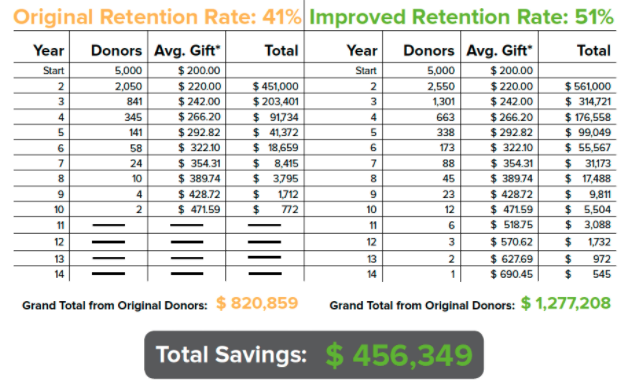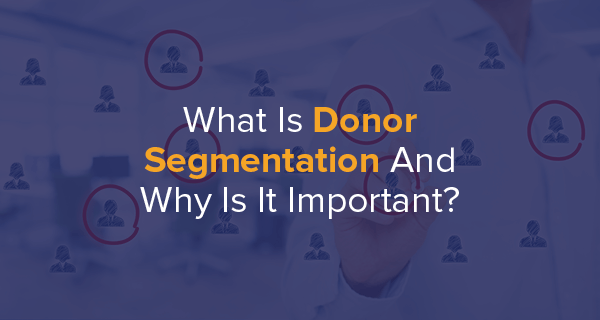Imagine that you just received a letter in the mail. What convinces you to open the envelope? If your name and address are handwritten or you recognize the return address, that might convince you it’s something you should pay attention to.
Let’s say you open the letter. What makes you read it all the way through? Maybe the sender used your name and discussed a cause that means a lot to you. These are personalization strategies that capture your attention and convince you that the letter is worth your time and energy.
When your nonprofit incorporates personalization elements into your marketing strategy, you’ll increase the likelihood that your supporters will read your messages and build a stronger relationship with your organization.
Segmentation is what enables your organization to personalize marketing messages to engage and build connections with your nonprofit’s supporters. In this guide, we’ll explore what segmentation is and how you can use it to connect with your nonprofit’s supporters on a deeper level. Let’s dive in.
Definition of donor segmentation
Bloomerang’s donor segmentation guide defines the term as “the process of separating your nonprofit supporters into groups based on common qualities and characteristics they share.” Nonprofits use this strategy to save time and reduce their reliance on generic, impersonalized messages.
You can create these segments within your nonprofit donor database using the information you collect about each of your donors through your donation pages. If your CRM software is integrated with your marketing solution, you can easily take donor segments and create email lists that allow you to send specific messages that will best engage each type of donor.
For example, your past volunteers will want to hear about how their time spent volunteering impacted your mission at large. However, this information may not engage your low-level donors who live several states away and can’t feasibly participate in your volunteer program.
Personalized segmentation leads to better retention.
When your supporters are more engaged with your nonprofit, they’re more likely to continue giving year after year. This should steadily increase your organization’s donor retention rate, the percentage of your supporters who continue to give to your nonprofit every year.
The more information you capture about your donors over the length of time they contribute to your organization, the more information you can collect about them in your nonprofit donor database about their interests and motivations. Using this information, you can further personalize communications, continuing the cycle and further engaging them.
How important is retention?
The average donor retention rate for nonprofits rests around 40-45% and has remained there for several years. By increasing your own retention rate, your nonprofit gains an opportunity to save money on acquisition expenses and raise more from your existing support base.
It costs about 10 times more to acquire new donors than it does to retain an existing one, which is why you should focus on retaining the donors you already have. Plus, when you retain supporters and continuously build a relationship with them, they’re more likely to continue giving into the future and to give in greater amounts.
Bloomerang’s donor retention guide highlights this example of a nonprofit that increased its retention rate by just 10% and saved $456,349.

As you can see, retention is the key to nonprofit growth. To increase your retention rate, you need to develop more personalized relationships with donors. This starts with using data to segment your donors.
How to segment donors
Now that the value of segmentation is clear, it’s time to move on to the natural next question: “What segments should my organization create?” All nonprofits will likely have segments that are best suited to their own audience and their own organization. However, there are some common guidelines that all nonprofits may consider adhering to.
As you create your own organization’s segments, consider the following questions:
How long have donors been giving? This helps measure the recency of giving. If a donor has given every year for the last four years, they can likely be counted on to give again this year. Meanwhile, if a donor gave only once and it was two years ago, you might categorize them as a lapsed contributor.
How often do donors give? The frequency of giving can also help create important donor segments. For instance, you might focus your communications with monthly recurring donors on engagement strategies outside of donating, such as volunteering or participating as a fundraiser in your next peer-to-peer campaign. This helps ensure you aren’t overwhelming your regular contributors with additional fundraising requests on top of their usual recurring gifts.
How are donors giving? The type of donations a supporter gives is key to determining how you’ll communicate with them. One supporter may give their time to your organization through volunteering, so your communication with them might centralize around encouraging a monetary donation. Meanwhile, you may encourage those who donate online to attend your upcoming event to get more involved.
How much are donors giving? Would you talk to your major donors the same way you would a first-time contributor? Probably not. That’s why you should have a segment for your major donors, as well as your first-time donors, mid-level contributors, etc.
Why do donors give? Identifying the motivation behind a supporter’s donation can be a great way to keep supporters updated with the information that is most valuable to them. For example, consider a nonprofit that conducts research for breast cancer. Donors may give because they had breast cancer themselves or because they lost a loved one to the disease. By taking note of this and incorporating that into your messaging, you have a better chance of deepening their connection to your cause.
What topics are donors most interested in? If donors are most interested in a particular project or campaign, send them more information about it. This holds their interest and ensures you’re giving them the most relevant information.
Your segments may differ from the nonprofit next door, and that’s OK! These are simply questions and guidelines that you can consider when creating your own donor segments. Think about the guidelines you’ll need to ensure the greatest engagement among your unique audience.
Common segments
While your segments should be unique to your organization, you may still need some inspiration for the types of segments you should create. The following are some of the most common donor segments that nonprofits create:
Monthly donors. Your nonprofit’s recurring donors are most likely to be retained year after year because their gift is automatically withdrawn from their bank account or hits their credit card on a regular basis. Create a segment of monthly donors and try to involve them in other activities. You should also find unique ways to thank them after each recurring gift. This strengthens their relationship with your cause and prevents the “set it and forget it” mentality.
First-time donors. First-time donors usually have the lowest retention rate—at an average rate of around 20%. Meanwhile, repeat donor retention rates average around 60%. Therefore, your goal for segmenting first-time donors is to cultivate the second or “golden” donation from supporters because it’s the fastest path to increasing your overall retention rate.
Lapsed donors. You shouldn’t give up on winning back your lapsed donors. At the very least, you should try reaching out once or twice to get them to give again. This isn’t the only value they could provide your nonprofit, however. These supporters can also be a valuable resource for information. Consider sending them a survey to ask why they lapsed so you can use that information to hopefully prevent other donors from lapsing in the future.
Volunteers who never gave. Volunteers have already shown a commitment to your cause. By encouraging them to donate if they haven’t done so before, your nonprofit can strengthen their involvement with your cause while raising additional funds. Keep in mind that volunteers may also be able to generate revenue through volunteer grants. According to Double the Donation, volunteer grant programs are a type of corporate philanthropy initiative wherein “companies provide monetary grants to organizations where employees regularly volunteer.” This makes volunteers an important source of revenue.
Donors who shared feedback. Donors who give feedback to your organization care about your organization’s success. Respond to their feedback and continue encouraging them to get involved. This should help you retain them over time.
Engaged social media followers. People who follow and engage with your organization on social media want to hear from your nonprofit. You can leverage this segment to get the word out about your various campaigns, specifically, those that take place largely on social media like Giving Tuesday or Facebook fundraising campaigns.
Long-term donors. Your long-term donors have given over the years and proven their loyalty to your cause. Therefore, you shouldn’t treat them like your first-time donors. Tell them about upcoming events and new opportunities to get involved. Or, review their history with your organization to show their impact over the years.
Develop the segments that will best serve your nonprofit. You know your organization better than anyone, so you know which segments will be most valuable.
Your nonprofit’s marketing and fundraising teams can use segmentation to more effectively reach out to and build relationships with your supporters, encouraging them to continue giving in the future. This helps your nonprofit increase your donor retention rate and raise more revenue.
Special thanks to Jay Love for sharing the expert advice. Jay is Co-Founder and current Chief Relationship Officer at Bloomerang
He has served this sector for 33 years and is considered the most well-known senior statesman whose advice is sought constantly.
Prior to Bloomerang, he was the CEO and Co-Founder of eTapestry for 11 years, which at the time was the leading SaaS technology company serving the charity sector. Jay and his team grew the company to more than 10,000 nonprofit clients, charting a decade of record growth.
He is a graduate of Butler University with a B.S. in Business Administration. Over the years, he has given more than 2,500 speeches around the world for the charity sector and is often the voice of new technology for fundraisers.
